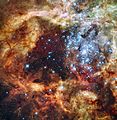Melnick 34 facts for kids
| Observation data Epoch J2000.0 Equinox J2000.0 |
|
|---|---|
| Constellation | Dorado |
| Right ascension | 5h 38m 44.26s |
| Declination | −69° 06′ 05.88″ |
| Apparent magnitude (V) | 13.09 |
| Characteristics | |
| Evolutionary stage | Wolf–Rayet star |
| Spectral type | WN5h + WN5h |
| B−V color index | +0.25 |
| Astrometry | |
| Radial velocity (Rv) | 287±5 km/s |
| Distance | 163,000 ly (49,970 pc) |
| Absolute magnitude (MV) | -7.42 |
| Orbit | |
| Period (P) | 154.55±0.05 d |
| Eccentricity (e) | 0.68±0.02 |
| Inclination (i) | ~50° |
| Periastron epoch (T) | 57671.2±0.9 JD |
| Argument of periastron (ω) (secondary) |
20.9±3.8° |
| Semi-amplitude (K1) (primary) |
130±7 km/s |
| Semi-amplitude (K2) (secondary) |
141±6 km/s |
| Details | |
| A | |
| Mass | 148 M☉ |
| Radius | 19.3±2.8 R☉ |
| Luminosity | 2,042,000 L☉ |
| Temperature | 53,000±1,200 K |
| Age | 0.5±0.3 Myr |
| B | |
| Mass | 135 M☉ |
| Radius | 18.2±2.7 R☉ |
| Luminosity | 1,585,000 L☉ |
| Temperature | 53,000±1,200 K |
| Age | 0.6±0.3 Myr |
| Other designations | |
|
BAT99 116, [HSH95] 8, Melnick 34, 2MASS J05384424-6906058, Brey 84
|
|
| Database references | |
| SIMBAD | data |
BAT99-116 (commonly called Melnick 34 or Mk34) is a binary Wolf–Rayet star near R136 in the 30 Doradus complex (also known as the Tarantula Nebula) in the Large Magellanic Cloud. Both parts are amongst the most massive and luminous stars known. It has a spectral type of WN5h and the most massive binary system with x-ray luminosity.
Images for kids

All content from Kiddle encyclopedia articles (including the article images and facts) can be freely used under Attribution-ShareAlike license, unless stated otherwise. Cite this article:
Melnick 34 Facts for Kids. Kiddle Encyclopedia.


